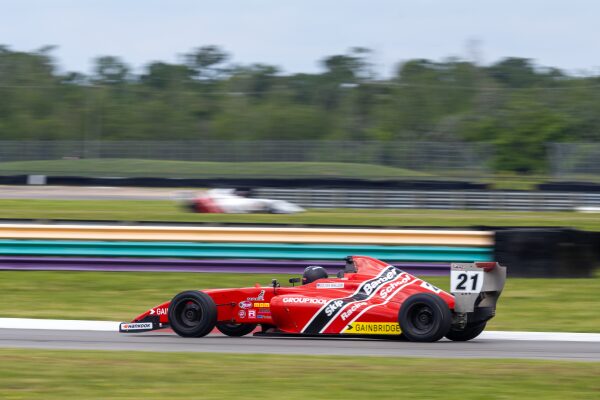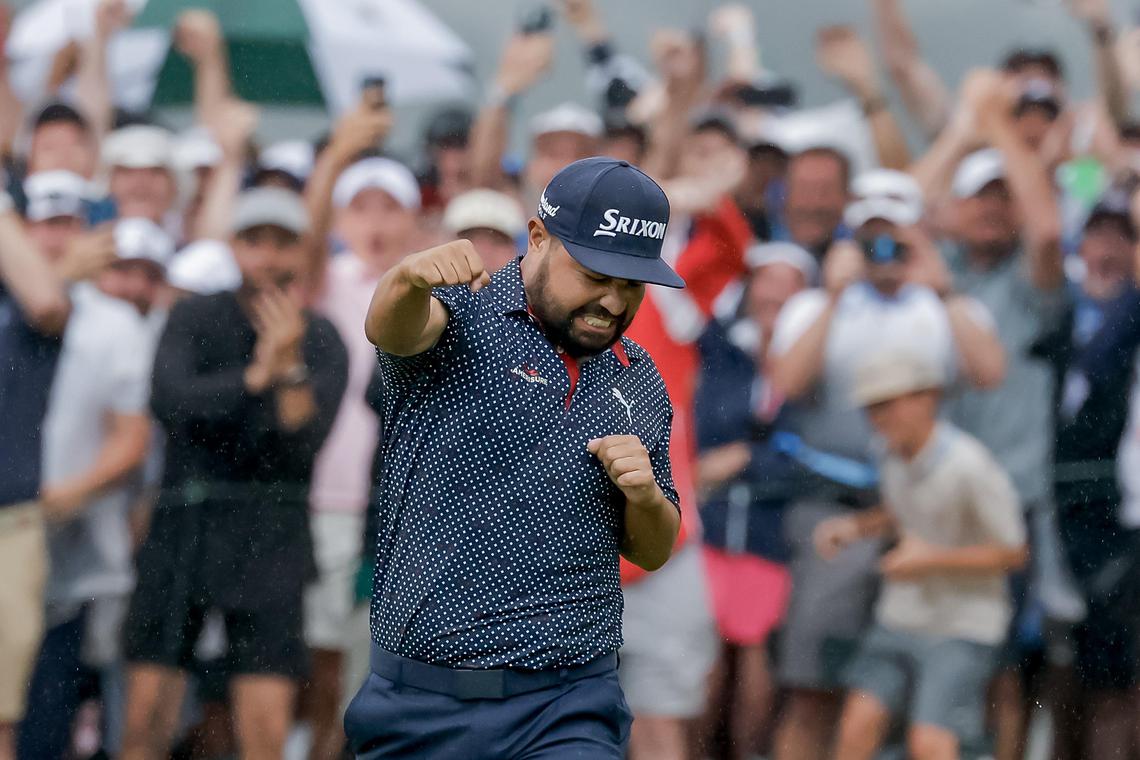News
Is Bryson DeChambeau Actually Relevant Again?

Bryson DeChambeau admits he wondered if there would ever be days like this again. Oh yeah, he also believes he can live until he is 120 years old. So there’s that…Listen to him proclaim it in the video below ???
This guy has been a total roller coaster during the past 2-3 years. The incredible weight gain that was done with a purpose also exacted a health toll. There were injuries to his hip and hand. The controversial move to LIV Golf, a lawsuit involving the PGA Tour (that he has since abandoned), and oh yeah, another diet.
I hate to say it but we keep it real here… let’s not forget a LOT of bad golf as well.
But there was a much different-looking DeChambeau on Thursday, one that sits atop the PGA Championship leaderboard in solo 2nd place at chilly Oak Hill Country Club, relishing a spot in the limelight again after a period when it seemed like every time we heard his name it was for all the wrong reasons.
“It’s been a while,” DeChambeau said after a 4-under-par 66 put him in solo 2nd on a stacked leaderboard. “So nice to come back and start to finally figure out what’s going on with my golf swing”. Well, it’s clearly a work in progress. Let’s admit it…Bryson DeChambeau is a content machine. And some of that content, well, it’s self-inflicted, like battling fire ants, tangentially comparing himself to George Washington and Albert Einstein before earning a tour card, and stating he thinks he can be the oldest human ever to live. But other times, DeChambeau is the unfortunate victim as the sport has a good-natured laugh at his expense, and one of those times happened Thursday when he wore a hat with the sponsor’s name misspelled. (see below)
“As I’ve told you guys before, I’ve struggled with my driving. You see me out there on the range. That’s something I don’t want to do. I don’t want to be out there all night, but I’ve had to figure out what I did so well in 2018 and what made me so successful then. I feel like I’m catching on and trending in that direction. Figured out a couple of things this week, and it certainly paid off today.” Except for when he drilled a fellow PGA golfer on the tee box with a wildly errant shot.
DeChambeau, 29, was lauded for his unique approach well before he began to add muscle and bulk in an effort to hit the ball farther.
Nicknamed the “Mad Scientist,” he plays with single-length irons and a quest for knowledge.
After winning four times on the PGA Tour in 2018, DeChambeau seemed on the perfect path, but he later got interested in trying to maximize his ability to hit the ball far.
He went on an intense weight-gaining and weight-training program that saw him become the longest driver on the PGA Tour. He won the 2020 U.S. Open, added a popular victory the next year at the Arnold Palmer Invitational, and had several other close calls, including a back-nine lead at the 2021 U.S. Open and a playoff loss to Patrick Cantlay at the BMW Championship.
Oh, and remember the feud with Brooks Koepka? Come on, no matter what side you were on for that ride, it was a fun one. Petty and hilarious at the same time. A priceless combo. This interview makes me laugh every time I see this leaked video footage … Just in case you forgot here it is again. We got you covered (Look at Brooksy’s Face) ‘Nuff Said LOL!
All of that seems quaint now. DeChambeau suffered through injuries early last year, including a broken hamate bone in his left hand and a hip problem. He jumped to LIV, never finished better than 10th in 48-player fields, and saw his world ranking plummet as LIV does not get Official World Golf Ranking points.
“A lot of diet changes and eating a lot, going from to 5,000 calories down to 2,900, whatever it is now,” he said. “But eating properly instead of eating stuff that inflames my body. I took a Zoomer peptide test, which essentially tells you what inflames your blood when you eat it. I was allergic to corn, wheat, gluten, and dairy. Pretty much everything I liked, I couldn’t eat. I took that out. Started taking it out in August and over the course of time I’ve lost all this inflammation, lost a lot of fat, and slimmed down like crazy.
“I lost 18 pounds in 24 days. It was crazy. It wasn’t fat. It was all water weight. You know how I looked before. I was not skinny. So a lot of changes in that regard. Obviously having the hand injury was no fun and then learning to play golf again with a new hand.”
If it sounds a bit frenetic, well, it is. That is DeChambeau’s world, which has included the spat with Koepka, his rift with equipment manufacturer Cobra at the 2021 British Open, his split with a caddie … and then the move to LIV, where he was given an equity stake in his LIV Golf team called the Crushers.
Through all of that, there was not much golf. His seventh-place finish last week at the LIV Golf Tulsa event was his best in 12 events. And his best anywhere since he tied for eighth last summer at the British Open at St. Andrews.
“He played great,” said Keegan Bradley, who played with DeChambeau and shot 68. “It looked like Bryson to me. He hit the ball great, putted great, drove it really nice. It was good to see him. He was smashing drives again, and he played pretty much flawless golf. Happy for him.”
DeChambeau hit nine of 14 fairways and 15 of 18 greens. He made just two bogeys and led the field in strokes gained off the tee and strokes-gained tee to green when he finished.
It was a pretty solid effort for a guy who has seemingly been lost in the golf wilderness for a long time. I mean really, ask yourself when was the last time you even heard his name before yesterday?
“Hitting the driver straight, finally,” DeChambeau said. “That’s been the most surprising part because I’m so used to hitting it everywhere. Look, it could happen tomorrow. I don’t think it will, but I feel really confident. Golf is a weird animal. You can never fully have it. Like Arnie (Palmer) said, you think you have it one day and then it just leaves the next. Just got to be careful.” Let’s sit back and enjoy this weekend’s wild ride. One thing is for sure. Whatever the outcome, I know I’ll have a front-row seat! Get your popcorn ?ready…
Blog
When Golf Meets Supercars: The World Series of Golf Takes Over Skip Barber’s Mexico Resort
World Series of Golf partners with Skip Barber Racing for a two-year luxury sports series at Gran Reserva, Mexico – where championship golf meets supercars starting April 2026.

Picture this. You’re standing on the 18th green at Gran Reserva, Mexico, finishing a round of championship golf with the World Series of Golf’s signature betting format still buzzing in your veins. The sun’s dropping low. Your heart’s still racing from that final putt.
And tomorrow? You’re driving a McLaren on Skip Barber’s brand-new racetrack.
Two Sports, One Unforgettable Weekend
The World Series of Golf just announced something we’ve never seen before. A two-year partnership with Skip Barber Racing School that transforms their new Mexican resort into the ultimate luxury sports destination. It’s not just golf. It’s not just racing. It’s both, wrapped into an experience that redefines what a sporting weekend can be.
Starting in April 2026, Gran Reserva becomes ground zero for a completely new kind of event.
Year One: The Foundation
The first year lays the groundwork. You’ll compete in the World Series of Golf championship using their patented tournament format – the one that adds poker-style betting mechanics to traditional stroke play and turns every hole into a strategic showdown. High stakes. Real tension. Golf the way it was meant to be played.
But here’s where it gets interesting. While you’re playing, Skip Barber’s building their racetrack right there on the property. You’ll see construction crews working on what will become one of North America’s most anticipated racing circuits. State-of-the-art simulators give you a taste of what’s coming, letting you experience the thrill of motorsports between rounds.
VIP receptions. Celebrity appearances. Curated culinary showcases that match the caliber of the competition. It’s an invitation-only event designed for people who expect excellence and aren’t willing to settle for anything less.
Year Two: The Payoff
Then 2027 hits. The track is finished. And suddenly you’re not just imagining what it’s like to drive a supercar at speed – you’re actually doing it.
McLaren. Ferrari. Mercedes. Lamborghini. Take your pick and put it through its paces on a circuit designed by people who’ve spent over 50 years teaching professional racers how to extract every ounce of performance from a machine. Skip Barber doesn’t mess around when it comes to motorsports education, and this track reflects that pedigree.

You’ll stay in exclusive luxury accommodations at Gran Reserva, network with athletes and industry leaders, and experience both golf and racing at the highest possible level. All in one place. All in one unforgettable weekend.
Why This Matters
Michael Berg, CFO of Skip Barber Racing School, called it perfectly: “Guests will see the racetrack under construction during our first event and then drive world-class vehicles on it the following year.”
That’s the hook. You’re not just attending an event. You’re watching it evolve. You’re part of the story from day one, and by year two, you’re living the payoff.
Robert Davidman, CEO of the World Series of Golf, added this: “This partnership unites golf and motorsports in an elevated format that caters to international fans seeking competition, luxury, and adventure.”
Competition. Luxury. Adventure. Three words that sum up what makes this special.
Why Sponsors Are Paying Attention
Here’s what makes this different from every other golf tournament trying to get your marketing dollars.
The World Series of Golf’s patent-protected format keeps spectators glued to every shot. Shot-by-shot wagering. Antes that double every three holes. Strategic decisions that matter as much as swing mechanics. It’s golf designed for television, and television designed to keep people watching.
Add Skip Barber Racing to the mix and you’ve got something networks actually want to cover. Over 40 hours of TV coverage. More than 15 million media impressions. Five million-plus social media reach. This isn’t a local tournament hoping for some local news pickup. This is a broadcast-ready event with an audience that’s already paying attention.
The demographics tell the rest of the story. You’re reaching affluent golf enthusiasts who also appreciate high-performance automobiles. International travelers who think nothing of flying to Mexico for a weekend of luxury sports. Decision-makers and industry leaders who network at VIP receptions and actually have the authority to sign deals on the spot.
Title sponsorship gets you naming rights, eight playing positions, and premium TV exposure throughout the broadcast. But even smaller packages deliver value. Hole sponsors get exclusive on-course branding and social media mentions for ten grand. Golf cart wraps guarantee TV and photo exposure because every shot of the tournament includes your brand.
The opportunities are limited by design. Only 18 hole sponsors. Three presenting sponsors. One title sponsor. Once they’re gone, they’re gone.
Want the details? Check out the full sponsorship packages at wsg.golf/sponsorship.
The Bottom Line
This isn’t your typical golf tournament. It’s not your standard track day either. It’s something entirely new – a two-year luxury sports series that gives you the best of both worlds and raises the bar for what a sporting experience can deliver.
Year one plants the seed. Year two delivers the harvest. And whether you’re attending as a player or partnering as a sponsor, you’ll be there for both.
For player inquiries, contact events@skipbarber.com. For sponsorship opportunities, reach out to sponsorship@wsg.golf. These events are strictly invitation-only, and opportunities won’t last long.
Golf and supercars. Mexico and motorsports. The World Series of Golf and Skip Barber Racing School.
This is going to be something special.

When JJ Spaun stood over a 64-foot birdie putt on the 72nd hole of the 2025 U.S. Open at Oakmont, few could have predicted what would come next. The ball meandered across the slick green, trickling over every contour, picking up speed at the crest, and then—like it had GPS—dropped center cup. Spaun dropped his putter, raised his arms, and the crowd erupted. With that single stroke, he claimed his first major title in one of the most dramatic finishes in U.S. Open history.
But how does Spaun’s putt stack up against other legendary finishes in the tournament’s storied past? Let’s break down some of the most iconic moments and see where this one lands.
1. Payne Stewart – 1999 U.S. Open at Pinehurst
Perhaps the most iconic putt in U.S. Open history came from Payne Stewart, who nailed a 15-footer for par on the 18th to win by one over Phil Mickelson. The pose—fist pump and outstretched leg—has since been immortalized in a statue at Pinehurst. What made it legendary wasn’t just the putt—it was the context: Stewart’s final major before his tragic death just months later.
Verdict: Iconic and emotional. Spaun’s putt was longer, but Stewart’s was more poetic.
2. Tiger Woods – 2008 U.S. Open at Torrey Pines
Woods drained a 12-foot birdie on the 72nd hole to force a playoff with Rocco Mediate—while basically playing on one leg. That tournament went to sudden death after an 18-hole playoff, and Tiger prevailed. This was peak Tiger drama, pain and all.
Verdict: Spaun’s putt was longer, but Tiger’s win was sheer willpower and mystique.
3. Jack Nicklaus – 1972 U.S. Open at Pebble Beach
With a 1-iron shot that hit the flagstick on 17 and a crucial birdie putt on 18, Jack sealed a dominant win. His precision and timing under pressure showed why he’s the GOAT.
Verdict: Not a putt for the win, but a signature finishing statement from Jack. Spaun’s was more electric in terms of pure putter drama.
4. Ben Hogan – 1950 U.S. Open at Merion
Hogan’s 1-iron into the 18th fairway and the par to force a playoff—just 16 months after a near-fatal car crash—remain legendary. He won the playoff and completed one of golf’s great comeback stories.
Verdict: Larger-than-life comeback. Spaun’s putt had more flair, but Hogan’s win was heroic.
5. JJ Spaun – 2025 U.S. Open at Oakmont
Let’s not underestimate what Spaun accomplished. The pressure was immense. He wasn’t the favorite. And on the most treacherous greens in golf, he buried a 64-foot bomb—a putt most players would be happy to lag to within 5 feet—to win the U.S. Open outright.
Verdict: For distance, surprise, and drama, Spaun’s putt may be the most shocking winning stroke in U.S. Open history.
Final Thoughts
JJ Spaun may not have the résumé of a Nicklaus or Woods, but for one Sunday afternoon in June 2025, he created a moment that will live in golf lore forever. Spaun’s putt was longer than Stewart’s, more unexpected than Tiger’s, and more dramatic than any final-hole finish in recent memory.
In terms of pure clutch putting? It might just be the greatest walk-off in U.S. Open history.
Blog
Meet The Canadian Open Qualifier Tied To ClickIt Golf!
“This week was incredible,” he said. “A dream come true.”

Josh Goldenberg doesn’t plan to quit his day job. But he had a great time dabbling in his old career.

He gave up on pro golf, then qualified for his first PGA Tour event.
Read the full story here
https://golf.com/news/josh-goldenberg-rbc-canadian-open/?amp=1
-

 Product Review6 years ago
Product Review6 years agoThe Perfect Practice Putting Mat Review by Jason Tenzer
-

 Blog4 years ago
Blog4 years agoLoophole Rule Offers PGA Tour Pros a Mulligan
-

 Blog4 years ago
Blog4 years ago2021 Buyer’s Guide: The Top 10 Value Golf Balls For Distance & Feel
-

 Blog5 years ago
Blog5 years agoGolf Marriage Counselor
-

 Blog6 years ago
Blog6 years ago9 Biggest Chokes Of The Past Decade
-

 Product Review6 years ago
Product Review6 years agoTHE ADJUSTABLE IRONS: WALKING STICKS GOLF CLUBS
-

 Blog4 years ago
Blog4 years agoWhat Your Golf Clubs Say About You
-

 Equipment6 years ago
Equipment6 years agoOHK Sports Interview by Jason Tenzer
















